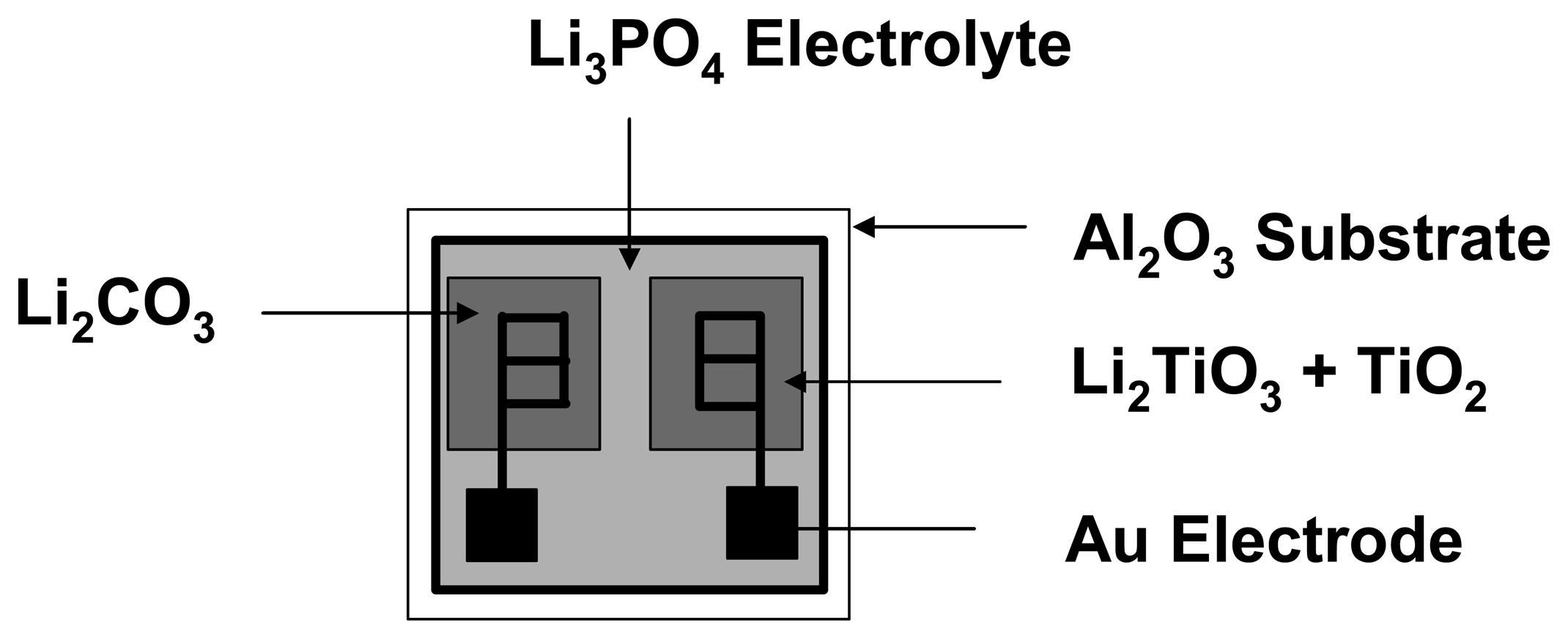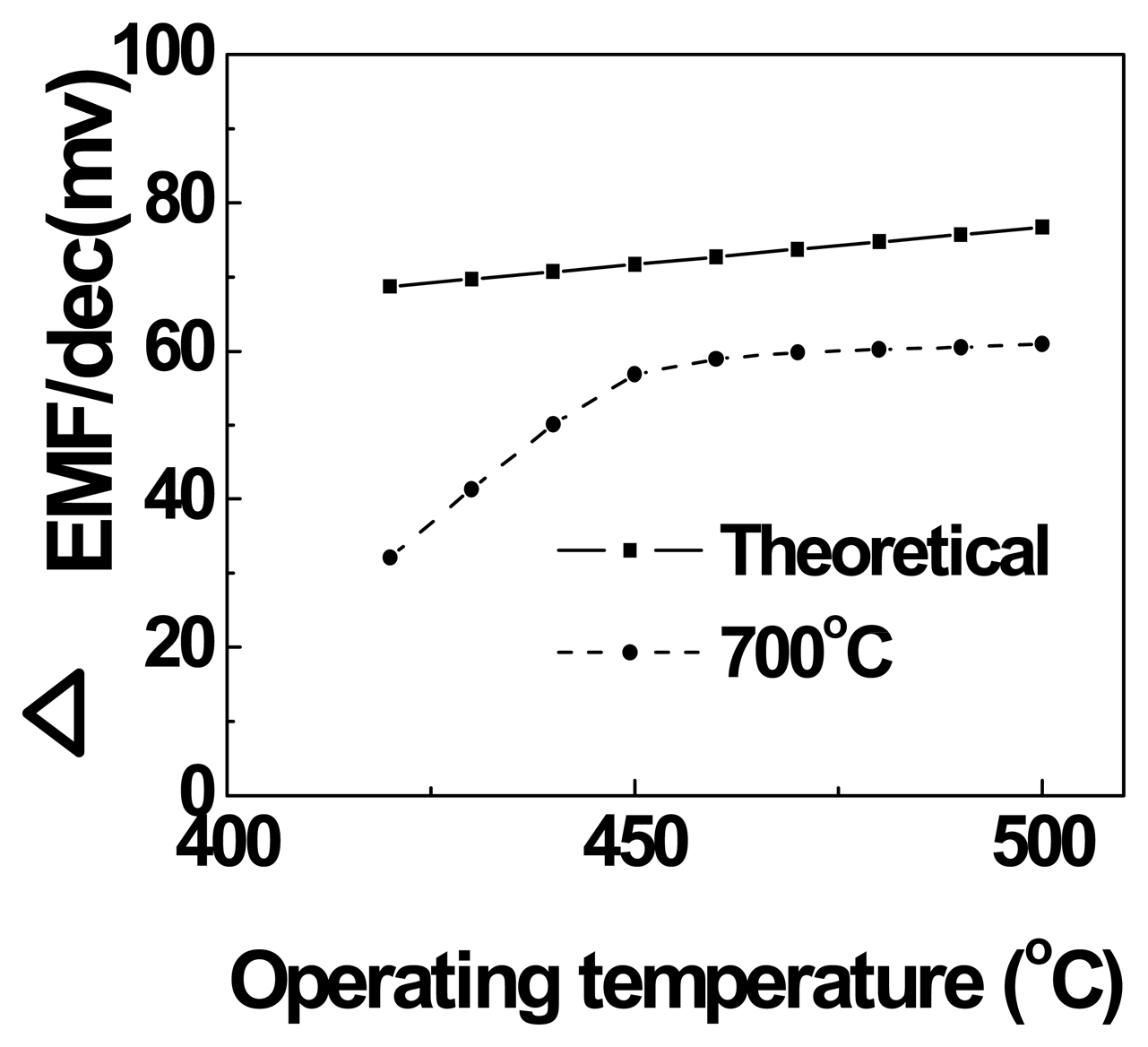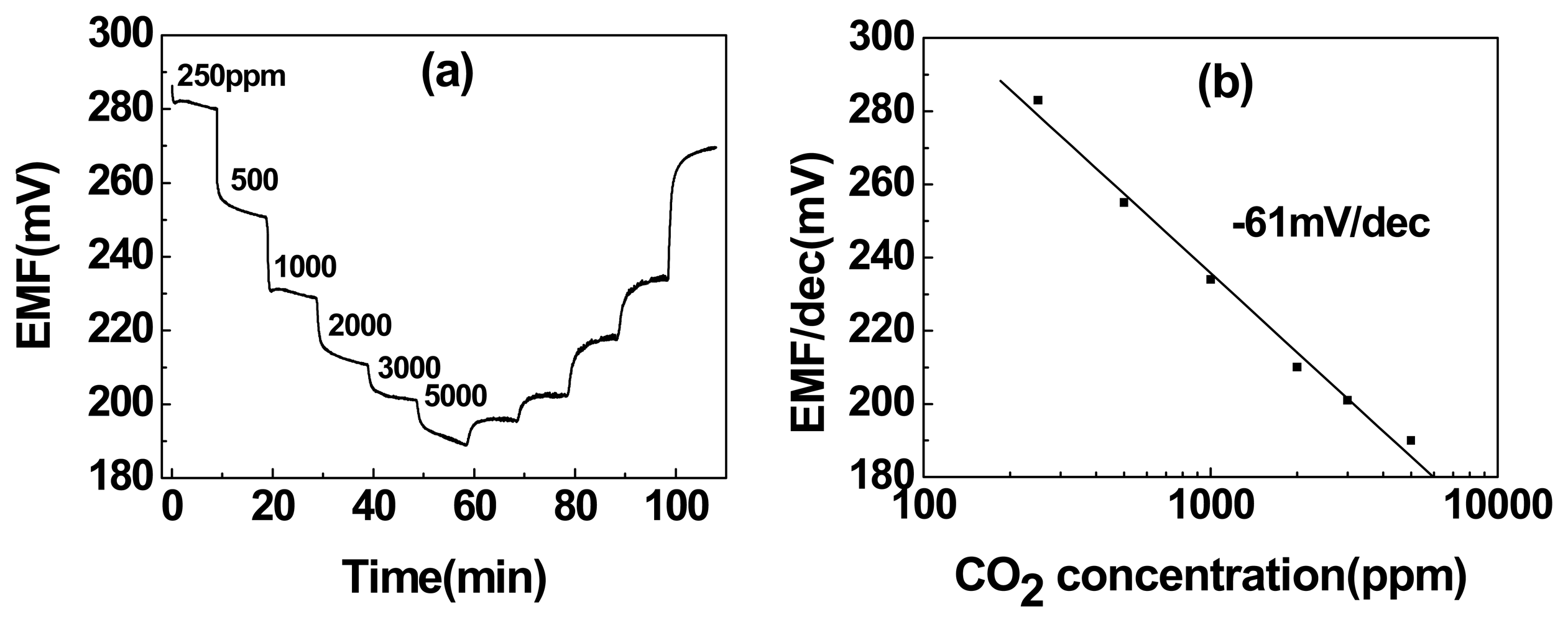Introduction
The alarming increase of industrial pollutants and combustible gas exhausts in the global environment have stimulated the development of selective, reproducible, long life and affordable CO
2 sensors in order to control the green house effects. Moreover, the use of CO
2 sensors in the fields of agriculture, automobile, air conditioning, chemical processing, and concrete industries have been increasing. Electrochemical sensors, which use the effect of the concentration on the equilibrium of the redox reactions occurring at the electrode-electrolyte interface in an electrochemical cell, are considered to be the most promising ones for the low level detection and monitoring of environmental pollutants such as NO
x, SO
x, HC and CO
2. According to Weppner, the potentiometric sensors in which the sensing electrode reaction converts the target gas to the mobile ion or the immobile ion or neither of them of the solid electrolyte are called as type I, II, and III potentiometric sensors [
1]. Among the type III sensors, potentiometric CO
2 sensor combining a solid electrolyte with an auxiliary phase of carbonate is eminently suited for practical applications [
2]. Li
+ ion conducting electrolyte [
3] and LIPON [
4] combined with a Li
2CO
3 auxiliary phase have been tried in view of their promising ability to use even in humid conditions due to the less reactivity with water [
5].
A typical potentiometric sensor is made up of three components such as an ionic conductor, a sensing or auxiliary phase and a reference electrode material. Most of the potentiometric sensors are being fabricated by bulk and stack type. Many researchers have been tried to use thick film technology in electrolyte fabrication [
6,
7]. Some researchers have also tried to make electrolyte, and sensing materials using thin film process [
8,
9]. However, some of the qualitative factors of these sensors are still need to be improved further.
In this experiment, we have adopted both thin and thick film processes for the development of a miniaturized, long life and cost effective CO2 sensor from a commercial point of view. The properties of the thin film electrolyte were studied with the variation of thickness, and operating temperature. The thin film electrolyte of Li3PO4 for potentiometric sensor may be the first attempt and result.
Experimental
Planar type CO
2 sensors were fabricated by using thick film process for sensing and reference materials and thin film process for solid electrolytes. Li
3PO
4 (Aldrich, 99.9%) thin films of 300 nm, 650 nm and 1.2 μm thickness were deposited on Al
2O
3 substrate by thermal evaporation. During deposition, the applied chamber pressure was 10
-6 Torr and power was 10 A. The as-deposited thin films were sintered at 700°C for 2 hr in air. Two Au electrodes were attached to the electrolyte thin films each at 2 mm apart and sintered at 700°C for 1 hr to make good contact with the electrolyte. Li
2TiO
3 (Aldrich, 99.99%) and TiO
2 (Aldrich, 99.9%) were mixed with an organic binder and grinded in a three roll mixer. The paste was screen printed of about 10 μm thicknesses on Au electrode as reference material and sintered at 700°C for 1 hr. In the similar way, Li
2CO
3 (Alfa Aesar 99.99%) paste was prepared and screen printed as sensing material and sintered at 600°C for 1 hr. The schematic diagram of the fabricated sensor is shown in
Fig.1. The overall dimensions of the fabricated sensor was 3mm × 3mm. Li
3PO
4 electrolyte was deposited over the whole area, though, the dimensions of the screen printed sensing and reference materials were 1mm × 1.5 mm.
The surface morphology and the cross section of the Li3PO4 thin films were observed by FE-SEM (Hitachi S-4700). The electromotive force, emf, of the sensor was measured by a two probe HP34401A multimeter of high impedance (above 10GΩ) connected to a computer through HP 34812A Benchlink software for data acquisition.
Results and discussion
In this work, the studied electrochemical sensor structure was
The emf measured for the open circuit gives the Li
+ ion activity ratio between the two interfaces, sensing electrode (a
LiI) and the reference electrode (a
LiII), of Li
3PO
4 electrolyte in accordance with
eqn (2),
where, F is the Farady's constant, R the gas constant and T the absolute temperature. The magnitude of a
LiI and a
LiII on the anodic and cathodic sides (measuring and reference electrodes) of the electrode reaction can be determined by
equations (3) and
(4)And the overall reaction for the open cell can be expressed as,
Thus, the oxygen partial pressure or chemical potential of the oxygen is same at both the electrodes and cancels in the overall cell reaction causing oxygen independency and hence the sensor depends only on the CO
2 partial pressure.
The SEM micrographs of the surface morphology of Li
3PO
4 electrolyte thin films are shown in
Fig.2. The pictures (a), (b), (c) represents the thin films of 300nm, 650nm, and 1.2um thickness sintered at 700°C for 30 m in air respectively. It is observed from the figure, that the grain size of thin films was increased with increasing thickness. In case of 300 nm deposited film (a), the morphology of Li
3PO
4 electrolyte is similar to that of alumina substrate because of less thin film thickness and high roughness of alumina substrate. Whereas, in the 650nm (b) and 1.2μm (c) thickness films, a different morphology of Li
3PO
4 electrolyte have been formed on the Al
2O
3 surface and their grain size is increased with thin film thickness. The film deposited of 1.2μm thickness and sintered at 700°C has an average grain size of 5μm and of uniform shape.
The dependence of emf as a function of concentration of CO
2 (logPco
2) for 300nm, 650nm and 1.2μm thickness electrolyte devices sintered at 700°C and operated at 500°C temperature are shown in
Fig. 3. It can be observed that the emf values were increased with increasing thickness of the electrolyte. The emf value of 300nm deposited electrolyte sensor is low while 650nm and 1.2μm deposited electrolyte sensors is high and similar. The low emf value of 300nm sensor is related to the low connectivity of Li
3PO
4 electrolyte as estimated from
Fig. 2(a). This suggests that a minimum thickness of electrolyte is needed to obtain a good emf value.
The Δemf/dec values obtained for sensors with various electrolyte thicknesses at different sintering and operating temperatures are shown in
Table.1. The emf values were increased with increasing electrolyte thickness and operating temperatures.
Fig.4 shows the dependence of Δemf/dec as a function of operating temperature for the sensor based on
Fig. 2(c). It can be seen from the figure, that the Δemf values were increased up to 460°C operating temperature, and reached a plateau between 460-500°C temperatures. The theoretically calculated Δemf values were showed in the figure as a continuous line. The theoretical value of -76.6 mV/dec was calculated from the equation -2.3(RT/nF), where n equals to 2 representing number of reaction electrons participating in the cell reaction at 500°C operating temperature, R the universal gas constant, T the absolute temperature and F the faraday constant. Between 460-500°C operating temperatures, the experimental values approached about 80% of theoretical value. However, the Δemf values below 460°C operating temperature are very low and much deviated from the theoretical values. This can be attributed to the effect of low kinetic energies produced between each electrode and the electrolyte and reaching a non-equilibrium state [
4].
It is found that in this temperature region the response and recovery of the sensor is good for all the investigated CO2 partial pressures.
Fig.5 (a) shows the sensitivity and recovery characteristics of the 1.2 μm thickness electrolyte sensor sintered at 700°C for different CO
2 concentrations at 500°C operating temperature. The sensor exhibits good response but some irreversible recovery.
Fig. 5 (b) shows the Δemf/dec as a function of CO
2 concentration. A Nernst's slope of -61mV/decade has been obtained between 250 to 5000 ppm of CO
2 concentration at 500°C temperature. It was observed for three months a satisfactory performance of the proposed sensor. However, sensing characteristic of the sensor can be improved further if the thickness and microstructure are optimized by the deposition process and sintering temperatures. The investigations will be reported elsewhere as soon as possible.









